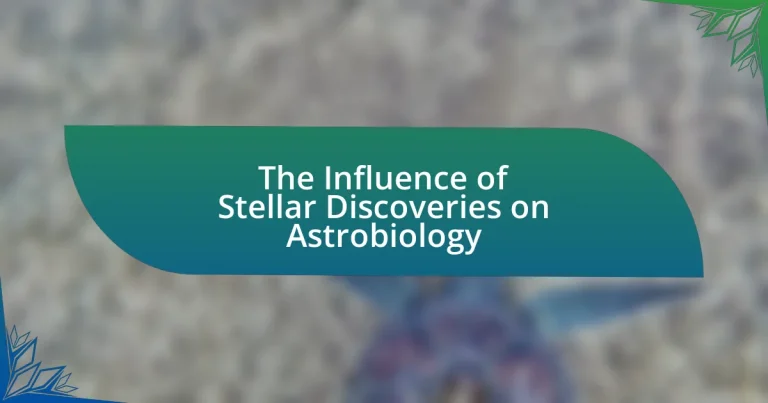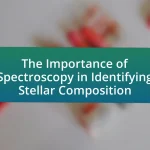The article examines the significant influence of stellar discoveries on the field of astrobiology, particularly in identifying exoplanets within habitable zones that may support life. It highlights the role of the Kepler Space Telescope in discovering thousands of exoplanets and discusses how the study of stellar types and their lifecycles informs our understanding of planetary habitability. Key methodologies, such as observational astronomy and interdisciplinary research, are explored, along with the implications of these discoveries for future astrobiological research and the search for extraterrestrial life. The article emphasizes the importance of integrating data from stellar observations into astrobiological models to enhance our understanding of life’s potential beyond Earth.

What is the Influence of Stellar Discoveries on Astrobiology?
Stellar discoveries significantly influence astrobiology by identifying exoplanets within habitable zones, which are crucial for the potential existence of life. For instance, the Kepler Space Telescope has identified thousands of exoplanets, many of which are located in regions where conditions may support liquid water, a key ingredient for life. These findings enhance our understanding of where to search for extraterrestrial life and inform models of planetary formation and evolution. Additionally, the study of stellar types and their lifecycles helps astrobiologists assess the stability of environments on orbiting planets, further refining the criteria for habitability.
How do stellar discoveries shape our understanding of life beyond Earth?
Stellar discoveries significantly enhance our understanding of life beyond Earth by revealing the conditions necessary for habitability and the potential for extraterrestrial life. For instance, the identification of exoplanets within the habitable zone of their stars, such as those found in the TRAPPIST-1 system, indicates that these planets may possess liquid water, a crucial ingredient for life as we know it. Furthermore, the detection of organic molecules in the atmospheres of distant planets and moons, like Titan and Europa, suggests that the building blocks of life are widespread in the universe. These findings support the hypothesis that life could exist in diverse environments beyond Earth, thereby expanding the scope of astrobiological research and guiding future exploration missions.
What types of stellar discoveries are most relevant to astrobiology?
The types of stellar discoveries most relevant to astrobiology include the identification of exoplanets, particularly those within the habitable zone, and the detection of biosignatures in stellar atmospheres. Exoplanets, especially those orbiting stars similar to the Sun, provide potential environments for life, as evidenced by the discovery of Earth-like planets in the habitable zone of their stars, such as Proxima Centauri b. Additionally, the detection of biosignatures, such as oxygen or methane in the atmospheres of exoplanets, indicates possible biological processes, supporting the search for extraterrestrial life. These discoveries are crucial as they directly inform the conditions under which life may arise and exist beyond Earth.
How do these discoveries inform the search for extraterrestrial life?
Discoveries of exoplanets and their atmospheres significantly inform the search for extraterrestrial life by identifying potentially habitable environments beyond Earth. For instance, the detection of water vapor and organic molecules in the atmospheres of exoplanets, such as those found in the TRAPPIST-1 system, suggests conditions that could support life. Additionally, the identification of biosignatures, like methane and oxygen, in these atmospheres provides concrete evidence that life-sustaining processes may exist elsewhere in the universe. These findings guide astrobiologists in selecting targets for further exploration and in developing models to understand the potential for life in diverse cosmic environments.
Why are stellar environments important for astrobiological studies?
Stellar environments are crucial for astrobiological studies because they provide the necessary conditions for the formation and evolution of life-supporting planets. The presence of stars influences the chemical composition of surrounding planetary systems, affecting the availability of essential elements like carbon, hydrogen, nitrogen, oxygen, phosphorus, and sulfur, which are fundamental for life as we know it. For instance, the habitable zone around a star, where temperatures allow for liquid water, is a key factor in determining a planet’s potential to support life. Research has shown that stars of different types, such as red dwarfs, can host numerous Earth-like planets in their habitable zones, thereby increasing the likelihood of finding extraterrestrial life.
What role do different types of stars play in planetary habitability?
Different types of stars significantly influence planetary habitability by determining the conditions under which planets can sustain life. For instance, stars like our Sun, classified as G-type main-sequence stars, provide a stable energy output over billions of years, allowing for the development of life-sustaining environments on orbiting planets. In contrast, M-type stars, or red dwarfs, have longer lifespans but emit less energy, which can lead to habitable zones being much closer to the star, increasing the likelihood of tidal locking and extreme temperature variations on planets.
Additionally, more massive stars, such as O and B types, have shorter lifespans and emit intense radiation, which can strip away planetary atmospheres, making it difficult for life to develop. Research indicates that the habitable zone, where conditions are right for liquid water, varies significantly depending on the star’s characteristics, with G-type stars offering the most favorable conditions for long-term habitability. Thus, the type of star plays a crucial role in shaping the potential for life on surrounding planets.
How do stellar lifecycles affect the potential for life on orbiting planets?
Stellar lifecycles significantly influence the potential for life on orbiting planets by determining the habitable conditions over time. As stars evolve, they undergo phases such as main sequence, red giant, and supernova, each affecting the energy output and stability of their systems. For instance, during the main sequence phase, a star provides a stable energy source, allowing for the development of life-sustaining environments on orbiting planets. However, when a star transitions to a red giant, it can lead to increased temperatures and radiation, potentially rendering nearby planets uninhabitable. Additionally, the death of a star in a supernova can obliterate surrounding planets, eliminating any existing life. Research indicates that the timing and duration of these stellar phases are critical; for example, the habitable zone around a star can shift as it ages, impacting the likelihood of life developing or persisting on orbiting planets.

What methodologies are used to study the influence of stellar discoveries on astrobiology?
The methodologies used to study the influence of stellar discoveries on astrobiology include observational astronomy, theoretical modeling, and interdisciplinary research. Observational astronomy involves the use of telescopes and instruments to gather data on stellar properties, such as luminosity and chemical composition, which can inform the potential habitability of exoplanets. Theoretical modeling employs simulations to predict how different stellar environments affect planetary atmospheres and the likelihood of life. Interdisciplinary research combines insights from astrophysics, biology, and planetary science to assess how stellar phenomena, like supernovae or solar flares, impact the conditions necessary for life. These methodologies collectively enhance our understanding of how stellar discoveries shape astrobiological prospects.
How do astronomers detect and analyze stellar phenomena?
Astronomers detect and analyze stellar phenomena primarily through the use of telescopes and various observational techniques. Telescopes, such as optical, radio, and space-based instruments, allow astronomers to capture light and other electromagnetic radiation emitted by stars. For instance, the Hubble Space Telescope has provided detailed images and spectra of distant stars, enabling the analysis of their composition, temperature, and motion.
Additionally, astronomers utilize spectroscopy to study the light from stars, which reveals information about their chemical makeup and physical properties. By analyzing the absorption and emission lines in a star’s spectrum, researchers can determine elements present and their relative abundances. This method has been crucial in identifying exoplanets and understanding stellar evolution.
Furthermore, advancements in technology, such as the use of photometry and astrometry, enhance the precision of measurements related to stellar brightness and position. These techniques contribute to the understanding of phenomena like variable stars and supernovae, providing insights into the life cycles of stars and their impact on surrounding environments, which is essential for astrobiological studies.
What technologies are employed in the search for exoplanets?
The technologies employed in the search for exoplanets include the transit method, radial velocity method, direct imaging, and gravitational microlensing. The transit method detects exoplanets by observing the dimming of a star’s light as a planet passes in front of it, a technique successfully utilized by NASA’s Kepler Space Telescope, which identified thousands of exoplanets. The radial velocity method measures variations in a star’s spectrum caused by the gravitational pull of an orbiting planet, providing evidence of its presence. Direct imaging captures images of exoplanets by blocking out the star’s light, allowing for the study of their atmospheres, as demonstrated by instruments like the Very Large Telescope. Gravitational microlensing occurs when a massive object, such as a star, magnifies the light of a more distant star, revealing potential exoplanets. These technologies collectively enhance our understanding of planetary systems beyond our own.
How do spectroscopic methods contribute to understanding stellar atmospheres?
Spectroscopic methods significantly enhance the understanding of stellar atmospheres by analyzing the light emitted or absorbed by stars. These methods allow astronomers to identify the chemical composition, temperature, density, and motion of stellar atmospheres through the analysis of spectral lines. For instance, the presence of specific absorption lines in a star’s spectrum indicates the elements present, such as hydrogen, helium, and heavier elements, which are crucial for understanding stellar evolution and nucleosynthesis. Additionally, Doppler shifts in these spectral lines provide insights into the star’s velocity and movement, contributing to the study of stellar dynamics. This information is vital for astrobiology, as it helps determine the potential habitability of exoplanets orbiting these stars by assessing their atmospheric conditions and chemical environments.
What interdisciplinary approaches enhance the study of astrobiology?
Interdisciplinary approaches that enhance the study of astrobiology include the integration of astronomy, biology, chemistry, geology, and planetary science. Astronomy provides insights into the conditions of exoplanets and stellar environments, while biology contributes understanding of life’s potential adaptations in extreme conditions. Chemistry is essential for analyzing the molecular building blocks of life, and geology offers knowledge about planetary processes and histories. For instance, the collaboration between astrobiologists and chemists has led to the discovery of amino acids in meteorites, supporting theories about the origins of life. This multifaceted approach allows for a comprehensive understanding of life’s potential beyond Earth, as evidenced by ongoing research in the field.
How do collaborations between astronomers and biologists advance our knowledge?
Collaborations between astronomers and biologists advance our knowledge by integrating insights from both fields to explore the potential for life beyond Earth. For instance, astronomers identify exoplanets in habitable zones, while biologists study extremophiles on Earth to understand the limits of life. This interdisciplinary approach has led to the development of astrobiology, which combines astronomical data with biological principles to assess the likelihood of life in various cosmic environments. Research such as the discovery of extremophiles in extreme conditions on Earth supports the hypothesis that life could exist in similar environments on other planets, thereby enhancing our understanding of life’s adaptability and the conditions necessary for its emergence.
What role does planetary science play in astrobiological research?
Planetary science plays a crucial role in astrobiological research by providing insights into the conditions necessary for life beyond Earth. It examines the physical and chemical properties of planets and moons, which helps scientists identify potentially habitable environments. For example, studies of Mars and the icy moons of Jupiter and Saturn have revealed the presence of water, essential for life, and organic molecules, which are building blocks of life. This information is vital for understanding where to search for extraterrestrial life and how life might adapt to different planetary conditions.

What are the implications of stellar discoveries for future astrobiological research?
Stellar discoveries significantly enhance future astrobiological research by identifying exoplanets within habitable zones, which increases the likelihood of finding extraterrestrial life. For instance, the discovery of the TRAPPIST-1 system, which contains seven Earth-sized planets, has provided concrete targets for studying atmospheric conditions and potential biosignatures. These findings guide the development of observational strategies and technologies, such as the James Webb Space Telescope, aimed at analyzing the chemical compositions of exoplanet atmospheres. Furthermore, understanding stellar environments helps researchers assess the stability of planetary systems, which is crucial for evaluating the potential for life. Thus, stellar discoveries directly inform the search for life beyond Earth by pinpointing where to look and what conditions may support life.
How might new stellar discoveries change our search for extraterrestrial life?
New stellar discoveries can significantly enhance our search for extraterrestrial life by identifying potentially habitable exoplanets and understanding the conditions necessary for life. For instance, the discovery of exoplanets in the habitable zone of their stars, such as those found in the TRAPPIST-1 system, provides concrete targets for further investigation. These planets exhibit conditions that may support liquid water, a critical ingredient for life as we know it. Additionally, advancements in spectroscopy allow scientists to analyze the atmospheres of these exoplanets for biosignatures, such as oxygen or methane, which could indicate biological processes. Thus, new stellar discoveries not only broaden the scope of our search but also refine our methods for detecting life beyond Earth.
What potential discoveries are on the horizon that could impact astrobiology?
Potential discoveries on the horizon that could impact astrobiology include the identification of biosignatures in the atmospheres of exoplanets and the detection of microbial life in extreme environments on Earth and other celestial bodies. The James Webb Space Telescope is expected to analyze the atmospheres of exoplanets, searching for gases like oxygen and methane that indicate biological processes. Additionally, missions to Mars and the icy moons of Jupiter and Saturn aim to uncover signs of life, enhancing our understanding of life’s potential beyond Earth. These discoveries could fundamentally alter our comprehension of where and how life might exist in the universe.
How can future missions be designed to leverage recent stellar findings?
Future missions can be designed to leverage recent stellar findings by incorporating advanced observational technologies and targeting exoplanets that exhibit conditions conducive to life. For instance, the discovery of potentially habitable exoplanets in the habitable zones of their stars, such as those identified by the Kepler Space Telescope, provides specific targets for future missions. These missions can utilize spectroscopic analysis to detect biosignatures in the atmospheres of these exoplanets, enhancing our understanding of astrobiological potential. Additionally, missions can be planned to study stellar phenomena, such as solar flares and their impact on planetary atmospheres, which are crucial for assessing habitability. By focusing on these areas, future missions can effectively utilize recent stellar discoveries to advance the field of astrobiology.
What practical steps can researchers take to integrate stellar discoveries into astrobiology?
Researchers can integrate stellar discoveries into astrobiology by developing interdisciplinary collaborations that combine astrophysics, planetary science, and biology. These collaborations can facilitate the sharing of data and methodologies, allowing for a comprehensive understanding of how stellar environments influence planetary habitability. For instance, studies on exoplanet atmospheres, such as those conducted by the Hubble Space Telescope, provide insights into the potential for life by analyzing chemical signatures indicative of biological processes. Additionally, researchers can utilize simulations of stellar radiation effects on planetary atmospheres to predict the viability of life in various stellar systems. This approach is supported by findings from the Kepler mission, which identified numerous exoplanets in habitable zones, emphasizing the importance of stellar characteristics in assessing life potential.
How can data from stellar observations be effectively utilized in astrobiological models?
Data from stellar observations can be effectively utilized in astrobiological models by providing critical information about the conditions of exoplanets and their host stars. Stellar data, such as luminosity, temperature, and spectral type, helps in assessing the habitable zone of stars, which is essential for determining the potential for life on orbiting planets. For instance, the Kepler Space Telescope has identified thousands of exoplanets, allowing researchers to analyze their sizes and distances from their stars, which directly informs models of planetary atmospheres and potential biosignatures. Additionally, understanding stellar activity, such as flares and radiation levels, is crucial for evaluating the habitability of planets, as these factors can influence atmospheric retention and surface conditions.
What best practices should be followed in interdisciplinary research efforts?
Best practices in interdisciplinary research efforts include fostering open communication, establishing clear goals, and integrating diverse methodologies. Open communication ensures that team members from different disciplines share insights and perspectives, which enhances collaboration. Establishing clear goals aligns the research objectives across disciplines, facilitating a unified approach. Integrating diverse methodologies allows for a comprehensive analysis of complex problems, as seen in studies like “Interdisciplinary Research: Process and Theory” by Klein, which emphasizes the importance of methodological diversity in achieving innovative outcomes. These practices are essential for effectively addressing the multifaceted challenges in fields such as astrobiology, where insights from astronomy, biology, and environmental science converge.




